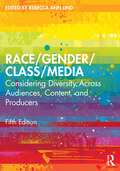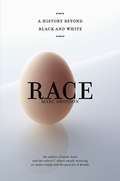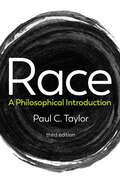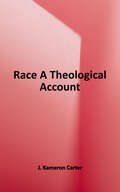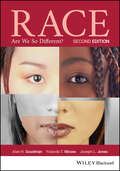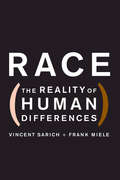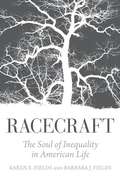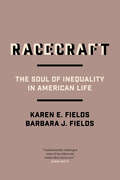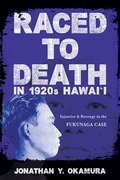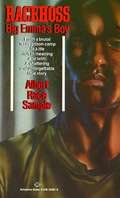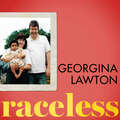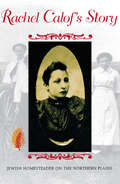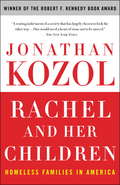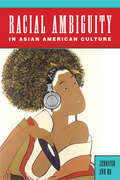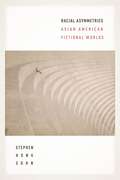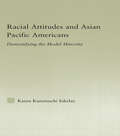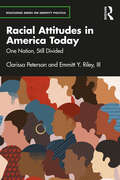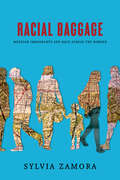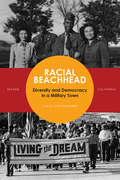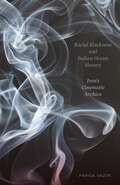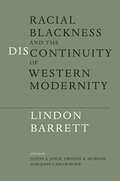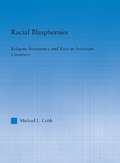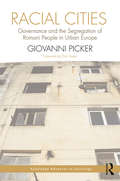- Table View
- List View
Race/Gender/Class/Media: Considering Diversity Across Audiences, Content, and Producers
by Rebecca Ann LindThe fifth edition of this popular textbook considers diversity in the mass media in three main settings: Audiences, Content, and Production. The book brings together 55 readings – the majority newly commissioned for this edition – by scholars representing a variety of humanities and social science disciplines. Together, these readings provide a multifaceted and intersectional look at how race, gender, and class relate to the creation and use of media texts, as well as the media texts themselves. Designed to be flexible for use in the classroom, the book begins with a detailed introduction to key concepts and presents a contextualizing introduction to each of the three main sections. Each reading contains multiple 'It’s Your Turn' activities to foster student engagement and which can serve as the basis for assignments. The book also offers a list of resources – books, articles, films, and websites – that are of value to students and instructors. This volume is an essential introduction to interdisciplinary studies of race, gender, and class across both digital and legacy media.
Race: A History Beyond Black and White
by Marc Aronson<p>Race. You know it at a glance: he's black; she's white. They're Asian; we're Latino. <p>Racism. I'm better; she's worse. Those people do those kinds of things. <p>We all know it's wrong to make these judgments, but they come faster than thought. <p>Why? Where did those feelings come from? Why are they so powerful? Why have millions been enslaved, murdered, denied their rights because of the color of their skin, the shape of their eyes? <p>Acclaimed young-adult historian Marc Aronson tackles these and other questions in this astounding book, which traces the history of racial prejudice in Western culture back to ancient Sumer and beyond. He shows us Greeks dividing the world into civilized and barbarian, medieval men writing about the traits of monstrous men, until, finally, Enlightenment scientists scrap all those mythologies and come up with a new one: charts spelling out the traits of human races. <p>Aronson's journey of discovery yields many surprising discoveries. For instance, throughout most of human history, slavery had nothing to do with race. In fact, the idea of race itself did not exist in the West before the 1600s. But once the idea was established and backed up by "scientific" theory, its influence grew with devastating consequences, from the appalling lynchings in the American South to the catastrophe known as the Holocaust in Europe. <p>With one hundred images, this is a dynamic, thought-provoking work-history as quest, written as only Marc Aronson could do it.</p>
Race: A Philosophical Introduction (Routledge Philosophy Companions Ser.)
by Paul C. TaylorThe third edition of Race: A Philosophical Introduction continues to provide the definitive guide to a topic of major contemporary importance. In this thoroughly updated and revised volume, Paul Taylor outlines the main features and implications of race-thinking, while engaging the ideas of important figures such as Linda Alcoff, K. Anthony Appiah, W. E. B. Du Bois, Michel Foucault and Sally Haslanger. The result is a comprehensive but accessible introduction to philosophical race theory and to a non-biological and situational notion of race, which blends metaphysics and social epistemology, aesthetics, analytic philosophy and pragmatic philosophy of experience. Taylor approaches the key questions in philosophy of race: What is race-thinking? Don’t we know better than to talk about race now? Are there any races? What is it like to have a racial identity? And how important, ethically, is color blindness? On the way to answering these questions, he takes up topics such as mixed-race identity, white supremacy, the relationship between the race concept and other social identity categories, and the impact of race-thinking on our erotic and romantic lives. The concluding section explores the racially fraught issues of policing, immigration, and global justice, and the implications of the political upheavals of the past decade, from the election of Donald Trump to the global upsurge in anti-immigrant populism. Updated throughout, Race remains a vital resource for the educated general reader as well as for students and scholars of ethnic studies, philosophy, sociology, and related fields.
Race: A Theological Account
by J. Kameron CarterThis groundbreaking monograph promises to open a new chapter in black theology. J. Kameron Carter argues that black theology's intellectual impoverishment in the Church and the academy is the result of its theologically shaky presuppositions, which are based largely on liberal Protestantconvictions. He critiques the work of such noted scholars as Albert Raboteau, Charles Long and James Cone, and argues that black theology must rebuild itself on completely new theological foundations. He lays these foundations by means of a remarkable synthesis between African-American religioushistory and Christian orthodoxy. Carter urges black theologians to look back beyond the Enlightenment and the rise of race theory, and to bring patristic Christology into conversation with the modern construction of race and being. He himself draws primarily on the writings of Irenaeus of Lyons,Gregory of Nyssa, and Maximos the Confessor in constructing his innovative Christology.
Race: Are We So Different?
by Alan H. Goodman Yolanda T. Moses Joseph L. JonesThe second edition of the bestselling title on modern notions of race, providing timely examination of perspectives on race, racism, and human biological variation In this fully updated second edition of this popular text on the study of race, Alan Goodman, Yolanda Moses, and Joseph Jones take a timely look at modern ideas surrounding race, racism, and human diversity, and consider the ways that ideas about race have changed over time. <p><p> New material in the second edition covers recent history and emerging topics in the study of race. The second edition has also been updated to account for advancements in the study of human genetic variation, which provide further evidence that race is an entirely social phenomenon. RACE compels readers to carefully consider their own ideas about race and the role that race plays in the world around them.
Race: The Reality of Human Differences
by Vincent SarichThe conventional wisdom in contemporary social science claims that human races are not biologically valid categories. Many argue the very words '?race? and ?racial differences? should be abolished because they support racism. In Race, Vincent Sarich and Frank Miele challenge both these tenets. First, they cite the historical record, the art and literature of other civilizations and cultures, morphological studies, cognitive psychology, and the latest research in medical genetics, forensics, and the human genome to demonstrate that racial differences are not trivial, but very real. They conclude with the paradox that, while, scientific honesty requires forthright recognition of racial differences, public policy should not recognize racial-group membership. The evidence and issues raised in this book will be of critical interest to students of race in behavioral and political science, medicine, and law.
Racecraft: The Soul Of Inequality In American Life
by Karen E. Fields Barbara J. FieldsMost people assume that racism grows from a perception of human difference: the fact of race gives rise to the practice of racism. Sociologist Karen E. Fields and historian Barbara J. Fields argue otherwise: the practice of racism produces the illusion of race, through what they call "racecraft." And this phenomenon is intimately entwined with other forms of inequality in American life. So pervasive are the devices of racecraft in American history, economic doctrine, politics, and everyday thinking that the presence of racecraft itself goes unnoticed. <p><p> That the promised post-racial age has not dawned, the authors argue, reflects the failure of Americans to develop a legitimate language for thinking about and discussing inequality. That failure should worry everyone who cares about democratic institutions.
Racecraft: The Soul of Inequality in American Life
by Barbara J. Fields Karen FieldsMost people assume that racism grows from a perception of human difference: the fact of race gives rise to the practice of racism. Sociologist Karen E. Fields and historian Barbara J. Fields argue otherwise: the practice of racism produces the illusion of race, through what they call "racecraft." And this phenomenon is intimately entwined with other forms of inequality in American life. So pervasive are the devices of racecraft in American history, economic doctrine, politics, and everyday thinking that the presence of racecraft itself goes unnoticed.That the promised post-racial age has not dawned, the authors argue, reflects the failure of Americans to develop a legitimate language for thinking about and discussing inequality. That failure should worry everyone who cares about democratic institutions.
Raced to Death in 1920s Hawai i: Injustice and Revenge in the Fukunaga Case (Asian American Experience #132)
by Jonathan Y OkamuraOn September 18, 1928, Myles Yutaka Fukunaga kidnapped and brutally murdered ten-year-old George Gill Jamieson in Waikîkî. Fukunaga, a nineteen-year-old nisei, or second-generation Japanese American, confessed to the crime. Within three weeks, authorities had convicted him and sentenced him to hang, despite questions about Fukunaga's sanity and a deeply flawed defense by his court-appointed attorneys.Jonathan Y. Okamura argues that officials "raced" Fukunaga to death—first viewing the accused only as Japanese despite the law supposedly being colorblind, and then hurrying to satisfy the Haole (white) community's demand for revenge. Okamura sets the case against an analysis of the racial hierarchy that undergirded Hawai‘ian society, which was dominated by Haoles who saw themselves most threatened by the islands' sizable Japanese American community. The Fukunaga case and others like it in the 1920s reinforced Haole supremacy and maintained the racial boundary that separated Haoles from non-Haoles, particularly through racial injustice. As Okamura challenges the representation of Hawai i as a racial paradise, he reveals the ways Haoles usurped the criminal justice system and reevaluates the tense history of anti-Japanese racism in Hawai i.
Racehoss: Big Emma's Boy
by Albert Race SampleHell for Albert Race Sample was the Retrieve, a branch of the Texas State prison system reserved for the most incorrigible prisoners. A cotton plantation where men slaved from dawn to dusk under the cruel leadership of "Boss Band," it cracked the spirits of the weak and hardened the souls of the strong. For "Racehoss," as Sample was called, the Retrieve was a place to witness unbearable brutality... which he recounts in awesome detail in the pages of this stunning book. It is the classic story of the son of a troubled mother, of a young man gone bad, and of his first tentative then tremendous steps toward reclaiming his own destiny. His ability to understand the forces that drove him to prison, and his devotion to helping others also see the light of change, earned Sample his release in 1972 and a full pardon in 1976. His story is gripping, powerful, and utterly real... true testament to the strength of the human spirit.
Raceless: Exploring race, identity and the truth about where I belong (Language Acts and Worldmaking #25)
by Georgina LawtonA GUARDIAN, SUNDAY TIMES, EVENING STANDARD AND COSMOPOLITAN BOOK OF THE YEAR FOR 2021In Georgina Lawton's childhood home, her Blackness was never acknowledged; the obvious fact of her brown skin, ignored by her white parents. Over time, secrets and a complex family story became accepted as truth and Georgina found herself complicit in the erasure of her racial identity.It was only when her beloved father died that the truth began to emerge. Fleeing the shattered pieces of her family life and the comfortable, suburban home she grew up in, at age 22 Georgina went in search of answers - embarking on a journey that took her around the world, to the DNA testing industry, and to countless others, whose identities have been questioned, denied or erased.What do you do when your heritage or parentage has been obscured in a complex web of deceit? How can you discuss race with your family, when you each see the world differently? When a personal identity has been wrongly constructed, how do you start again?Raceless is a beautifully-written true account of a young woman seeking her own story amid devastating family secrets. For readers of powerful, moving books about family, growing up and identity, such as My Name is Why by Lemn Sissay and Educated by Tara Westover.
Raceless: In Search of Family, Identity, and the Truth About Where I Belong
by Georgina Lawton'A jaw-dropping story, told deftly... a gripping, thought-provoking book.' The Sunday Times'Freshly fascinating. [Lawton] is a particularly astute observer of the psychological dislocation caused by growing up mixed race... and she writes beautifully about questions of identity and belonging, so central to each of us in finding our particular place in the world.' New York Times Book Review'A poignant and eye opening memoir...a nuanced and crucial dissection of race as a construct.' Yomi Adegoke, co-author of Slay in Your Lane'A beautifully written account of an extraordinary story, Raceless is as eye-opening as it is profound.' Otegha UwagbaA Guardian, Sunday Times, Evening Standard and Cosmopolitan book of the year for 2021'Ideas from our parents form the backbone to our identities, the bedrock to personal truths that we recite and remember like prayers from Church or poems from school. But they condition us in more powerful ways than lessons from any book or religion ever could. Now the tale had been destroyed. So what did that mean about who I thought I was?'In Georgina Lawton's childhood home, her Blackness was never acknowledged; the obvious fact of her brown skin, ignored by her white parents. Over time, secrets and a complex family story became accepted as truth and Georgina found herself complicit in the erasure of her racial identity. It was only when her beloved father died that the truth began to emerge. Fleeing the shattered pieces of her family life and the comfortable, suburban home she grew up in, at age 22 Georgina went in search of answers - embarking on a journey that took her around the world, to the DNA testing industry, and to countless others, whose identities have been questioned, denied or erased.What do you do when your heritage or parentage has been obscured in a complex web of deceit?How can you discuss race with your family, when you each see the world differently? When a personal identity has been wrongly constructed, how do you start again? Raceless is both the compelling personal account of a young woman seeking her own story amid devastating family secrets, and a fascinating, challenging and essential examination of modern racial identity.
Raceless: In Search of Family, Identity, and the Truth About Where I Belong
by Georgina LawtonA Bustle Most Anticipated Debut of the YearFrom The Guardian’s Georgina Lawton, a moving examination of how racial identity is constructed—through the author’s own journey grappling with secrets and stereotypes, having been raised by white parents with no explanation as to why she looked black.Raised in sleepy English suburbia, Georgina Lawton was no stranger to homogeneity. Her parents were white; her friends were white; there was no reason for her to think she was any different. But over time her brown skin and dark, kinky hair frequently made her a target of prejudice. In Georgina’s insistently color-blind household, with no acknowledgement of her difference or access to black culture, she lacked the coordinates to make sense of who she was.It was only after her father’s death that Georgina began to unravel the truth about her parentage—and the racial identity that she had been denied. She fled from England and the turmoil of her home-life to live in black communities around the globe—the US, the UK, Nicaragua, Cuba, the Dominican Republic, Vietnam, and Morocco—and to explore her identity and what it meant to live in and navigate the world as a black woman. She spoke with psychologists, sociologists, experts in genetic testing, and other individuals whose experiences of racial identity have been fraught or questioned in the hopes of understanding how, exactly, we identify ourselves.Raceless is an exploration of a fundamental question: what constitutes our sense of self? Drawing on her personal experiences and the stories of others, Lawton grapples with difficult questions about love, shame, grief, and prejudice, and reveals the nuanced and emotional journey of forming one’s identity.
Rachel Calof's Story: Jewish Homesteader on the Northern Plains
by Rachel Calof"Calof's [story] has the 'electricity' one occasionally finds in primary sources. It is powerful, shocking, and primitive, with the kind of appeal primary sources often attain without effort. . . . it is a strong addition to the literature of women's experience on the frontier." —Lillian SchlisselIn 1894, eighteen-year-old Rachel Bella Kahn travelled from Russia to the United States for an arranged marriage to Abraham Calof, an immigrant homesteader in North Dakota. Rachel Calof's Story combines her memoir of a hard pioneering life on the prairie with scholarly essays that provide historical and cultural background and show her narrative to be both unique and a representative western tale. Her narrative is riveting and candid, laced with humor and irony.The memoir, written by Rachel Bella Calof in 1936, recounts aspects of her childhood and teenage years in a Jewish community, (shtetl) in Russia, but focuses largely on her life between 1894 and 1904, when she and her husband carved out a life as homesteaders. She recalls her horror at the hardships of pioneer life—especially the crowding of many family members into the 12 x 14' dirt-floored shanties that were their first dwellings. "Of all the privations I knew as a homesteader," says Calof, "the lack of privacy was the hardest to bear." Money, food, and fuel were scarce, and during bitter winters, three Calof households—Abraham and Rachel with their growing children, along with his parents and a brother's family—would pool resources and live together (with livestock) in one shanty.Under harsh and primitive conditions, Rachel Bella Calof bore and raised nine children. The family withstood many dangers, including hailstorms that hammered wheat to the ground and flooded their home; droughts that reduced crops to dust; blinding snowstorms of plains winters. Through it all, however, Calof drew on a humor and resolve that is everywhere apparent in her narrative. Always striving to improve her living conditions, she made lamps from dried mud, scraps of rag, and butter; plastered the cracked wood walls of her home with clay; supplemented meagre supplies with prairie forage—wild mushrooms and garlic for a special supper, dry grass for a hot fire to bake bread. Never sentimental, Caolf's memoir is a vital historical and personal record.J. Sanford Rikoon elaborates on the history of Jewish settlement in the rural heartland and the great tide of immigration from the Russian Pale of Settlement and Eastern Europe from 1880–1910. Elizabeth Jameson examines how Calof "writes from the interior spaces of private life, and from that vantage point, reconfigures more familiar versions of the American West." Jameson also discusses how the Calofs adapted Jewish practices to the new contingencies of North Dakota, maintaining customs that represented the core of their Jewish identity, reconstructing their "Jewishness" in new circumstances.
Rachel and Her Children: Homeless Families in America
by Jonathan KozolThe story that jolted the conscience of the nation when it first appeared in The New Yorker. Jonathan Kozol is one of America's most forceful and eloquent observers of the intersection of race, poverty, and education. His books, from the National Book Award-winning Death at an Early Age to his most recent, the critically acclaimed Shame of the Nation, are touchstones of the national conscience. First published in 1988 and based on the months the author spent among America's homeless, Rachel and Her Children is an unforgettable record of the desperate voices of men, women, and especially children caught up in a nightmarish situation that tears at the hearts of readers. With record numbers of homeless children and adults flooding the nation's shelters, Rachel and Her Children offers a look at homelessness that resonates even louder today.
Racial Ambiguity in Asian American Culture
by Professor Jennifer Ann HoThe sheer diversity of the Asian American populace makes them an ambiguous racial category. Indeed, the 2010 U.S. Census lists twenty-four Asian-ethnic groups, lumping together under one heading people with dramatically different historical backgrounds and cultures. In Racial Ambiguity in Asian American Culture, Jennifer Ann Ho shines a light on the hybrid and indeterminate aspects of race, revealing ambiguity to be paramount to a more nuanced understanding both of race and of what it means to be Asian American. Exploring a variety of subjects and cultural artifacts, Ho reveals how Asian American subjects evince a deep racial ambiguity that unmoors the concept of race from any fixed or finite understanding. For example, the book examines the racial ambiguity of Japanese American nisei Yoshiko Nakamura deLeon, who during World War II underwent an abrupt transition from being an enemy alien to an assimilating American, via the Mixed Marriage Policy of 1942. It looks at the blogs of Korean, Taiwanese, and Vietnamese Americans who were adopted as children by white American families and have conflicted feelings about their "honorary white" status. And it discusses Tiger Woods, the most famous mixed-race Asian American, whose description of himself as "Cablinasian"--reflecting his background as Black, Asian, Caucasian, and Native American--perfectly captures the ambiguity of racial classifications. Race is an abstraction that we treat as concrete, a construct that reflects only our desires, fears, and anxieties. Jennifer Ho demonstrates in Racial Ambiguity in Asian American Culture that seeing race as ambiguous puts us one step closer to a potential antidote to racism.
Racial Asymmetries: Asian American Fictional Worlds
by Stephen Hong SohnChallenging the tidy links among authorial position, narrative perspective, and fictional content, Stephen Hong Sohn argues that Asian American authors have never been limited to writing about Asian American characters or contexts. Racial Asymmetries specifically examines the importance of first person narration in Asian American fiction published in the postrace era, focusing on those cultural productions in which the author’s ethnoracial makeup does not directly overlap with that of the storytelling perspective.Through rigorous analysis of novels and short fiction, such as Sesshu Foster’s Atomik Aztex, Sabina Murray’s A Carnivore’s Inquiry and Sigrid Nunez’s The Last of Her Kind, Sohn reveals how the construction of narrative perspective allows the Asian American writer a flexible aesthetic canvas upon which to engage issues of oppression and inequity, power and subjectivity, and the complicated construction of racial identity. Speaking to concerns running through postcolonial studies and American literature at large, Racial Asymmetries employs an interdisciplinary approach to reveal the unbounded nature of fictional worlds.
Racial Attitudes and Asian Pacific Americans: Demystifying the Model Minority (Studies in Asian Americans)
by Karen Kurotsuchi InkelasThis study examines the complex sources and implications of the racial attitudes of Asian Pacific American (APA) college students, who, as one of the fastest growing demographics in higher education enrollments, play an increasingly significant role in campus race relations.
Racial Attitudes in America Today: One Nation, Still Divided (Routledge Series on Identity Politics)
by Clarissa Peterson Emmitt Y. Riley, IIIWith this book, Clarissa Peterson and Emmitt Y. Riley, III dive into how racial attitudes change and inform political decisions. Peterson and Riley use racial resentment, black blame, and racial identity to investigate the extent to which racial attitudes influence vote choice, evaluations of Black Lives Matter, and attitudes toward public policies. Moving the conversation beyond the study of Blacks and Whites, the authors unpack the potency of racial attitudes among Asians, Blacks, Hispanics, and Whites. In doing so, they challenge our understanding of how racial attitudes are central to political decision making in an environment that is inundated with anti-Blackness. The book reframes discussions of racial attitudes to propose that, like White people, some racial minorities in the United States harbor negative attitudes toward Black people. The authors suggest that while White political attitudes are significantly explained by racial resentment, the overall influence of racial resentment on political decision making among some racial groups, may be mitigated by racial identity. At a time when White supremacists walk unhooded in the streets of America, Racial Attitudes in America Today is essential reading for educators wanting to fully engage with and understand racial resentment in America and undergraduate students in the fields of political science, sociology, history, and psychology.
Racial Baggage: Mexican Immigrants and Race Across the Border
by Sylvia ZamoraUpon arrival to the United States, Mexican immigrants are racialized as simultaneously non-White and "illegal." This racialization process complicates notions of race that they bring with them, as the "pigmentocracy" of Mexican society, in which their skin color may have afforded them more privileges within their home country, collides with the American racial system. Racial Baggage examines how immigration reconfigures U.S. race relations, illuminating how the immigration experience can transform understandings of race in home and host countries. Drawing on interviews with Mexicans in Los Angeles and Guadalajara, sociologist Sylvia Zamora illustrates how racialization is a transnational process that not only changes immigrants themselves, but also everyday understandings of race and racism within the United States and Mexico. Within their communities and networks that span an international border, Zamora argues, immigrants come to define "race" in a way distinct from both the color-conscious hierarchy of Mexican society and the Black-White binary prevalent within the United States. In the process, their stories demonstrate how race is not static, but rather an evolving social phenomenon forever altered by immigration.
Racial Beachhead
by Carol Lynn MckibbenIn 1917, Fort Ord was established in the tiny subdivision of Seaside, California. Over the course of the 20th century, it held great national and military importance—a major launching point for World War II operations, the first base in the military to undergo complete integration, the West Coast's most important training base for draftees in the Vietnam War, a site of important civil rights movements—until its closure in the 1990s. Alongside it, the city of Seaside took form. Racial Beachhead offers the story of this city, shaped over the decades by military policies of racial integration in the context of the ideals of the American civil rights movement. Middle class blacks, together with other military families—black, white, Hispanic, and Asian—created a local politics of inclusion that continues to serve as a reminder that integration can work to change ideas about race. Though Seaside's relationship with the military makes it unique, at the same time the story of Seaside is part and parcel of the story of 20th century American town life. Its story contributes to the growing history of cities of color—those minority-majority places that are increasingly the face of urban America.
Racial Blackness and Indian Ocean Slavery: Iran's Cinematic Archive
by Parisa VaziriRethinking the history of African enslavement in the western Indian Ocean through the lens of Iranian cinema From the East African and Red Sea coasts to the Persian Gulf ports of Bushihr, Kish, and Hurmuz, sailing and caravan networks supplied Iran and the surrounding regions with African slave labor from antiquity to the nineteenth century. This book reveals how Iranian cinema preserves the legacy of this vast and yet long-overlooked history that has come to be known as Indian Ocean slavery. How does a focus on blackness complicate traditional understandings of history and culture? Parisa Vaziri addresses this question by looking at residues of the Indian Ocean slave trade in Iranian films from the second half of the twentieth century. Revealing the politicized clash between commercial cinema (fīlmfārsī) and alternative filmmaking (the Iranian New Wave), she pays particular attention to the healing ritual zār, which is both an African slave descendent practice and a constitutive element of Iranian culture, as well as to cinematic sīyāh bāzī (Persian black play). Moving beyond other studies on Indian Ocean and trans-Saharan slavery, Vaziri highlights the crystallization of a singular mode of historicity within these cinematic examples—one of &“absence&” that reflects the relative dearth of archival information on the facts surrounding Indian Ocean slavery. Bringing together cinema studies, Middle East studies, Black studies, and postcolonial theory, Racial Blackness and Indian Ocean Slavery explores African enslavement in the Indian Ocean through the revelatory and little-known history of Iranian cinema. It shows that Iranian film reveals a resistance to facticity representative of the history of African enslavement in the Indian Ocean and preserves the legacy of African slavery&’s longue durée in ways that resist its overpowering erasure in the popular and historical imagination. Retail e-book files for this title are screen-reader friendly with images accompanied by short alt text and/or extended descriptions.
Racial Blackness and the Discontinuity of Western Modernity
by Dwight A. Mcbride John Carlos Rowe Justin A. Joyce Lindon BarrettThe unfinished manuscript of literary and cultural theorist Lindon Barrett, this study offers a genealogy of how the development of racial blackness within the mercantile capitalist system of Euro-American colonial imperialism was constitutive of Western modernity. Masterfully connecting historical systems of racial slavery to post-Enlightenment modernity, this pathbreaking publication shows how Western modernity depended on a particular conception of racism contested by African American writers and intellectuals from the eighteenth century to the Harlem Renaissance.
Racial Blasphemies: Religious Irreverence and Race in American Literature (Literary Criticism and Cultural Theory)
by Michael L. CobbRacial Blasphemies, using critical race theory and literary analysis, charts the tense, frustrated religious language that saturates much twentieth-century American literature. Michael Cobb argues that we should consider religious language as a special kind of language - a language of curse words - that furiously communicates not theology or spirituality as much as it signals the sheer difficulty of representing race in a non-racist manner on the literary page.
Racial Cities: Governance and the Segregation of Romani People in Urban Europe (Routledge Advances in Sociology)
by Giovanni PickerGoing beyond race-blind approaches to spatial segregation in Europe, Racial Cities argues that race is the logic through which stigmatized and segregated "Gypsy urban areas" have emerged and persisted after World War II. Building on nearly a decade of ethnographic and historical research in Romania, Italy, France and the UK, Giovanni Picker casts a series of case studies into the historical framework of circulations and borrowings between colony and metropole since the late nineteenth century. By focusing on socio-economic transformations and social dynamics in contemporary Cluj-Napoca, Pescara, Montreuil, Florence and Salford, Picker detects four local segregating mechanisms, and comparatively investigates resemblances between each of them and segregation in French Rabat, Italian Addis Ababa, and British New Delhi. These multiple global associations across space and time serve as an empirical basis for establishing a solid bridge between race critical theories and urban studies. Racial Cities is the first comprehensive analysis of the segregation of Romani people in Europe, providing a fine-tuned and in-depth explanation of this phenomenon. While inequalities increase globally and poverty is ever more concentrated, this book is a key contribution to debates and actions addressing social marginality, inequalities, racist exclusions, and governance. Thanks to its dense yet thoroughly accessible narration, the book will appeal to scholars, undergraduate and postgraduate students, postdoctoral researchers, and equally to activists and policy makers, who are interested in areas including: Race and Racism, Urban Studies, Governance, Inequalities, Colonialism and Postcolonialism, and European Studies.
